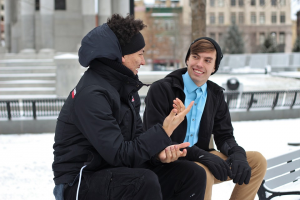2 Introductions and Greetings
In this chapter, you will learn how to:
- Describe yourself and other people
- Learn how to use follow-up questions and phrases in a conversation

Discussion Questions
- Look at the photo of Harmony Day, a holiday in Australia. What do you think the holiday is about?
- How do the people in the photo know each other? What are they doing?
Chapter 2 Vocabulary
Part 1 Directions
Use your dictionary to find the meaning for the vocabulary words in the box above. Then write the words from the box next to their definitions below.
- Something that you enjoy doing or learning about
- The process of teaching and learning
- To say what something looks or feels like
- An area of land controlled by a government
- The way people are connected to one another, such as a family
- A group of people who are about the same age
- Someone who enjoys being with other people
- A person or thing that is liked more than others
- A group of people who live in the same area
- One person or part of a larger group
Part 2 Directions
Read the questions below. Find and underline each vocabulary word in the questions. Then ask your partner the questions.
- Are you a social person? Do you prefer to spend time individually?
- What is your favorite thing about your community in your country?
- How is your generation different from your parents’ generation?
Part 3 Directions
Listen to the pronunciation of the vocabulary words. Write the vocabulary word then listen again and write the number of syllables that you hear in each word. The first word has been done for you. Mark the syllables on each of the words.

- In-ter–est (3)
- ______________________
- ______________________
- ______________________
- ______________________
- ______________________
- ______________________
- ______________________
- ______________________
- ______________________
Listening for Details and Main Ideas
Part A Directions
Listen to the person introduce herself and describe her interests. Then answer the questions below.

- Where does Samantha go to school?
- How many years has Samantha been in college?
- What job would Samantha like in the future?
- What are Samantha’s hobbies?
- What is the main idea of this listening? Circle one.
Samantha’s life in college
Samantha’s life
Samantha’s hobbies
Samantha’s family
Part B Directions
Now listen to Samantha talk about her grandmother. After you listen, answer the questions below.

- How old is Samantha’s grandmother?
- How many years was Samantha’s grandmother a teacher?
- What are Samantha’s grandmother’s hobbies?
- Which of Samantha’s hobbies does her grandmother not like?
- Which hobby do they do together?
Part C Directions
Using the information that you heard about Samantha and her grandmother, complete the chart below
| Samantha | Her Grandmother | |
| Age | ||
| Hobbies | ||
| Dislikes |
Part D Directions
Discuss the questions below with your partner or in a small group.
- Do you think Samantha and her grandmother are more similar to each other or more different?
- Why do you think different generations have different hobbies?
- What hobbies are popular for people in your generation?
- What hobbies were popular in your grandparents’ generation?
Grammar Tip: Subject Pronouns and Possessive Adjectives
Subject Pronouns /Possessive Adjectives
I —My
You—Your
She —Her
He—His
It—Its
We—Our
They—Their
Subject pronouns are used when you are talking about the person as the subject of the sentence. They are often followed by a verb.
Examples: I am a student. She is a teacher. They like to travel.
Possessive adjectives are used when you are talking about something that belongs to a person or place. They are often followed by a noun.
Examples: My car is red. Their bus is late. Our classroom is big.
Practice:
Answer the questions below using complete sentences. Then underline the subject pronouns in your answers and circle the possessive adjectives.
Grammar Tip: 3rd person “s”
In English, when you talk about another person or thing, the verb always has an “s” added to it.
Subject/ Verb /Object
I like pizza.
You like pizza.
He, She, It, likes pizza.
We like pizza.
They like pizza.
The 3rd person “s” is always used when talking about another person in the present tense.
Do not use the 3rd person “s”:
- for negative sentences
- to talk about the past or future
Examples:
Third person “s”: She likes pizza.
Negative: She doesn’t like pizza.
Third person “s”: He speaks English.
Past tense: He didn’t speak English.
Future tense: He will speak English.
Practice 1

Listen to the statements. Circle the form of the verb that you hear.
a) like b) likes
a) play b) plays
a) take b) takes
a) eat b) eats
a) read b) reads
a) ride b) rides
a) speak b) speaks
Practice 2
Ask your partner the 5 questions and write their complete answers below. Use the correct form of the third person pronoun or possessive adjective and the 3rd person form of the verb.
What is your name?
Where are you from?
What language do you speak?
What is your hobby?
What is your favorite food?
Homework Survey
Practice your English outside of the classroom. Find 5 Americans or strong users of English and ask them questions below. Write their complete answers. Use correct grammar in your answers.
Remember to first introduce yourself and to thank the person when you are finished.
“Hello, I’m an English student. My name is…” “Do you have a minute to help me with my homework?” “Thank you very much. It’s nice to meet you.”
What is your name?
Where are you from?
What is your job?
Can you suggest a good restaurant?
What is your name?
Where are you from?
What is your job?
Can you suggest a good restaurant?
What is your name?
Where are you from?
What is your job?
Can you suggest a good restaurant?
What is your name?
Where are you from?
What is your job?
Can you suggest a good restaurant?
What is your name?
Where are you from?
What is your job?
Can you suggest a good restaurant?
Listening to a Conversation
Directions: Listen to Abdullah and Amy talk about the activities that they like to do. Fill in the blanks in the conversation below with the vocabulary words that you hear. After you listen, practice reading the conversation with a partner.
Abdullah: Hey Amy, how are you?
Amy: Hi Abdullah, I’m good. How are you?
Abdullah: I’m good. I’m working on a project for my class.
Amy: Oh, really? What is it about?
Abdullah: I have to for a presentation.
Amy: Oh, that sounds interesting. What are your activities to do?
Abdullah: Well, I’m a really person, so I like to hang out with friends and do things in my . What about you?
Amy: Me too! I’m also a social person, but I like to do individual activities as well.
Abdullah: Tell me more. Like what?
Amy: For example, I really enjoy reading. Do you?
Abdullah: Yes, I do. But, I believe this hobby was more popular in previous in my country.
Amy: Really?
Abdullah: Yes, today people my age like to use social media and the internet.
Amy: Cool. I understand. I think it’s the same in my .
Abdullah: Cool. I think it’s that way in many now. Well, I
have to go now. See you around!
Amy: OK. Nice talking to you. Good luck on your project!
Speaking tip: Follow up Questions and Phrases
When you are talking with someone in English, there are many ways to keep a conversation going. One way is to use follow-up questions.
After you answer a question, return the question with these phrases:
What about you?
How about you?
Why? Really?
Interesting. Tell me more.

Go back to the conversation on the page before between Amy and Abdullah and listen to how the speakers use the follow-up questions and phrases.
Practicing Conversations
Now practice writing a conversation of your own. Work with your partner to write a conversation. Introduce yourselves and talk about your hobbies and interests. Use follow-up questions and statements and include 5 of the Chapter 2 vocabulary words in your conversation.
A.
B.
A.
B.
A.
B.
A.
B.
A.
B.
A.
Chapter 2 Review
In this chapter, you learned:
- Grammar tips for talking about other people
- Some follow-up questions to use in conversations
Extra Listening Practice
How would you describe yourself?
What is your name? Where are you from?
Diana discusses her new hobby and shares her skill level.
Naomi, a middle school student from Wales, talks about her free time activities.




